SaaS Marketing Automation: All You Need to Know
15.11.2022 – Art Malkovich
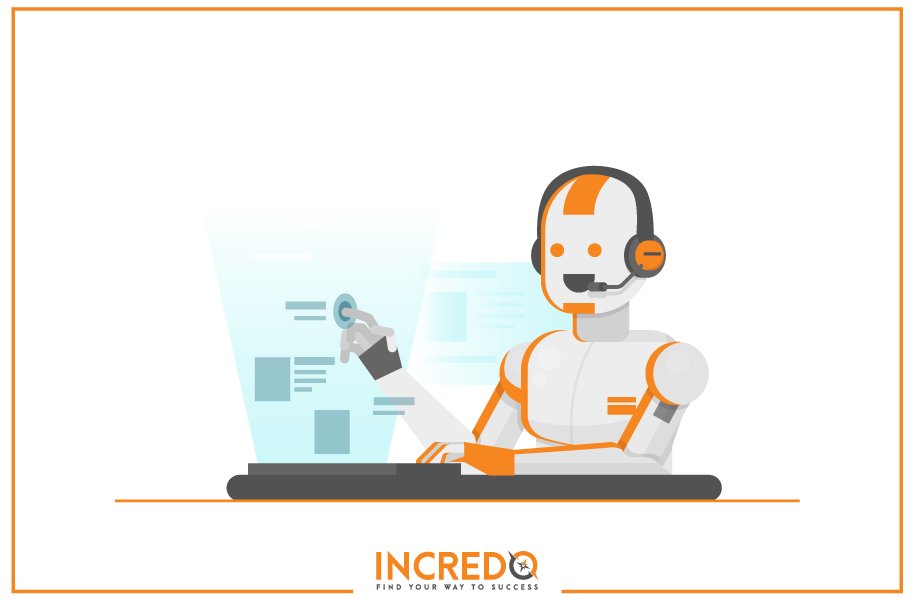
SaaS Marketing Automation: All You Need to Know
As a growing SaaS company, do you want to know how to deal with the increasing number of online activities? As everyone goes online to do business, find a solution to a problem, and acquire the needed information, the competition in any sphere heats up. It applies to every sphere, including SaaS companies.
For example, statistics prove that the SaaS market size has increased three times in the past five years. And SaaS adoption will increase as it helps companies expand and reach their goals, according to 93% of CIOs (chief information officers).
There are several ways to stand out from the crowd in the SaaS industry. You need to keep an active online presence, engage potential clients, and bring value to encourage them to stay with the brand.
Does it all sound intimidating? Don’t worry. SaaS marketing automation will help you deal with numerous tasks simultaneously. This guide will provide insights into SaaS marketing automation, its benefits, and the ways to make it possible.
What Is SaaS Marketing Automation?
It is the process of transforming manual operations into computerized ones. It involves using SaaS marketing automation software to complete marketing tasks. For example, it helps you send messages at scale, through the required channel, and at the right time.
MarTech tools let you start a dialog with customers and prospects based on the established triggers and terms. That’s why you need to predefine certain events for a system to act every time a subscriber needs it.
Let’s take email marketing automation as an example. Suppose you create a one-off email and deliver it to a recipient. And next time, you’ll need to compile a new email for another person for the same goal.
As opposed to that, marketing automation reuses existing campaigns to similar cases. For example, you can create an onboarding email and program it to be sent every time users register on the website. The system will employ this template for numerous people for as long as needed.
What Problems SaaS Marketing Automation Solves
Many people imagine emails when they hear the phrase “marketing automation”. But it’s much more than email campaigns. Software for marketing automation can make the following tasks more efficient:
- lead scoring, nurturing, and generation;
- audience targeting and segmentation;
- improving cross-selling propositions;
- setting up customer retention and loyalty initiatives;
- providing reporting and analytics;
- enhancing marketing and content strategy based on analytics. That is, tweaking headings, ads, or time for sending emails or notifications;
- finding the most effective headlines, offers, content, or graphics with A/B testing;
- collecting precise customer data and creating more accurate client profiles.
The Advantages of SaaS Marketing Automation Software
Automated marketing reduces labor costs. You can get better results by programming repetitive processes, lowering human error, and saving time. Equipping manual processes with dedicated tools allows you to concentrate on strategic activities like:
- defining goals;
- research;
- drafting campaign strategy;
- design like adding crucial navigation elements;
- sustaining brand consistency;
- assessing KPIs, and more.
We can continue the list of marketing automation advantages, with the most noteworthy ones being as follows:
- providing a better customer experience;
- ensuring user satisfaction;
- personalizing the experience;
- reactivating abandoned registration;
- promoting product adoption;
- boosting employee productivity.
What Types of SaaS Marketing Automation Software Exist?
SaaS marketing automation tools generally include systems for the following purposes:
- competitive intelligence;
- pricing;
- distribution;
- inventory management.
Following that, here is a list of various software categories in marketing automation:
- Pricing for creating competitive pricing structures, typically in eCommerce. You can determine the best pricing strategy with the help of A/B testing and demand estimation.
- Email marketing as a tool for facilitating email marketing. It entails putting up lead generation forms and reports to monitor progress.
- Social media, which includes content posting, scheduling, monitoring, and analytics. Its purpose is to automate many parts of social media marketing.
- Online advertising for improving and streamlining ad generation and digital channel bidding.
- Lead management, which deals with lead generation and scoring.
- Customer loyalty for launching related programs. Clients can collect points and get rewards, such as discounts, gifts, cashback, etc.
- Customer relationship management (CRM). It contains customer, order, and product data and automates sales operations.
- Sales automation for gathering data, accessing analytics, and dealing with sales processes.
- Marketing automation workflows, reducing the need for human intervention in marketing strategies.
- Analytics to visualize data and find trends in market and customer information.
Solutions come in a wide variety of forms. Some suppliers provide standalone products to combine them with other systems to function. Others offer comprehensive packages that include many (if not all) of the products mentioned above.
3 Inspiring Marketing Automation Ideas for SaaS Companies
1. Practice Lead Scoring & Grading
You can gain a lot by separating leads into specific groups, for example:
- Evaluate their readiness to communicate and do business with you.
- Customize your interaction and focus on interested prospects or give it up if the lead doesn’t need your offer.
A case in point is Salesforce. As one of the best marketing automation CRM for SaaS on the market, it can assist you in lead generation and organizing workflow processes. Salesforce offers adjustable and personalized automated lead scoring and grading. It also includes Pardot, a marketing automation platform.
Below you can see how the AI-powered tool assigns a lead score (88) to a client and specifies their status, company, title, and industry. There are also sections with a behavioral score (91), statistics, and engagement history.
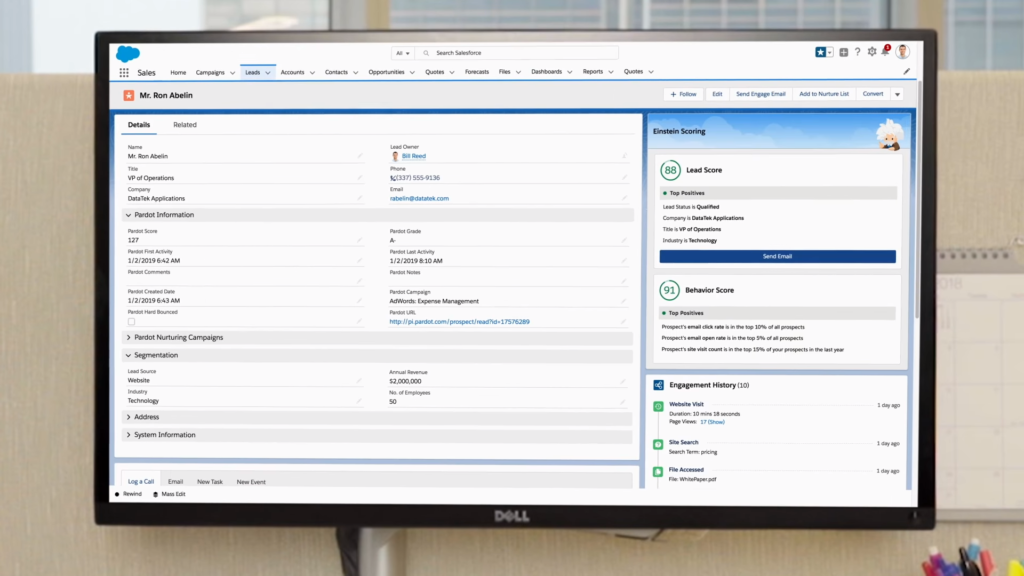
The solution considers prospects’ activities. It then calculates the level of interest and willingness to do business. What actions can it analyze? For example, one of the metrics is how much time the person has spent on the website.
After that, you can assign the lead to the most appropriate representative to communicate with them and close a deal. For instance, you can check their location and transfer to an agent in a specific region.
2. Introduce Email Marketing Automation
Email marketing continues to be the most effective in the industry despite being one of the oldest types of digital marketing. It’s also among the top digital marketing channels in terms of popularity. However, as more consumers subscribe to the newsletter, the company should ensure scalability. That is where email marketing software comes in to help you preset messages for your contacts.
These automation technologies enable the wide-scale delivery of customized emails. They often include performance assessment dashboards to check crucial email marketing metrics. As you can automate everything in email marketing, some send-outs may lack a human touch and sound robotic. That’s why you should enhance the email copy by automatically personalizing its elements, including:
- subject lines;
- calls to action;
- body text, etc.
This strategy lets you maintain the high quality of the marketing messages and transfer repetitive tasks to the system. Many marketing automation systems come with integrated email marketing platforms. But if you’re searching for the best standalone email marketing automation solution for a SaaS company, consider tools like Litmus and MailChimp. Here is what you can send to your audience after subscribing.
- Onboarding series
Welcome emails provide an opportunity to leave a lasting impression on subscribers. A one-time welcome email or a series of emails should assist in onboarding users and creating an outstanding experience. How? A great example is the Klaviyo marketing automation platform and its onboarding email in the screenshot below. The vendor describes its products and their benefits to encourage people to buy.
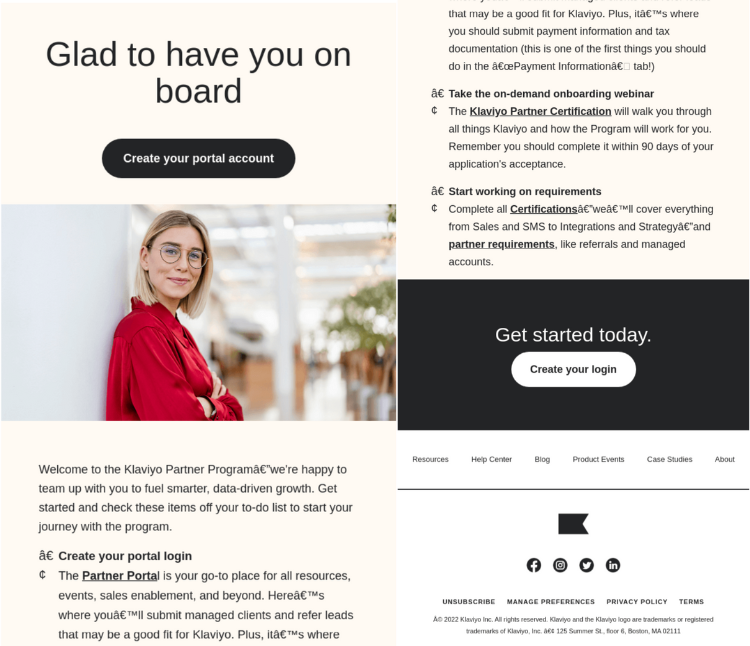
- Discounts
Guess what will boost your sales? A timely discount offer. Customers expect value from the company when subscribing to a newsletter. And deals provide such a chance by enabling clients to save some cash. Dedicate offers to holidays as Restream live video platform does.
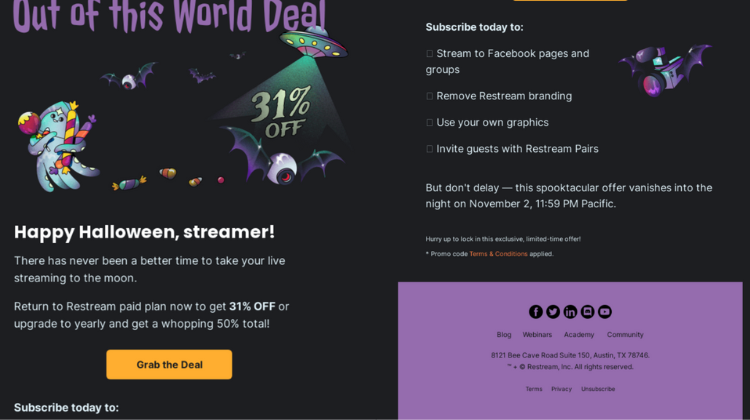
- Product updates & launches
A brand can reach out to its customers in many ways, and using marketing automation makes it easier than ever.
A good example is product launches and updates. Consider a screenshot of the Figma email below, in which the company introduces new features. It’s a great email to send to Figma users because it lets them know what to expect from the upcoming release.
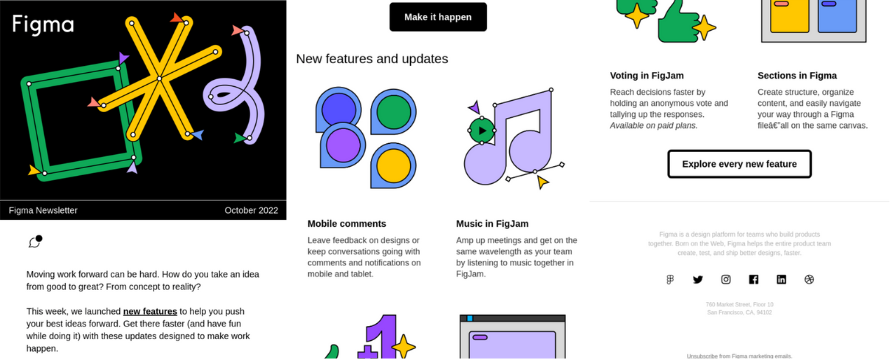
- Re-engagement emails
Send an email to interact with inactive email subscribers. Encourage them to complete the order or renew their subscription with a “Save on your next order” coupon or an abandoned cart offer. Harvest, a time tracking tool, sends this letter to appeal to the user and reactive trial.
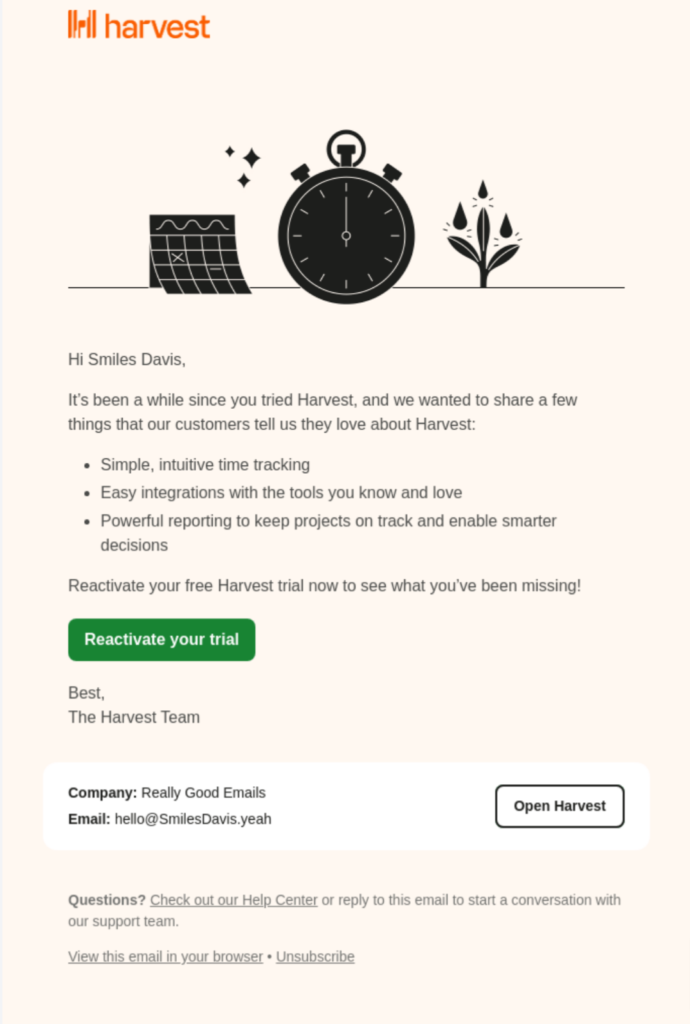
- Emails for collecting feedback or conducting surveys
Another wonderful example of marketing automation is sending out surveys. Ask users for feedback on goods, services, and updates. Specify cases for initiating an email, like completing an order or upgrading the program, site, or product.
These emails show your interest in customers’ opinions and expertise, raising customer satisfaction with the company. For example, Shopify addresses developers among their users to participate in a 5-minute survey. See the screenshot below for an illustration.

- Congratulations on special occasions
Celebrate when someone signs up for your product, places their first order, or reaches other important milestones, not to mention birthdays. Configure an automatic email once individuals achieve something.
It’s a great chance to make money. So consider incorporating a special deal to entice readers to shop. Take Grammarly in the screenshot below. The company offers a 40% discount dedicated to the first anniversary of being its client.
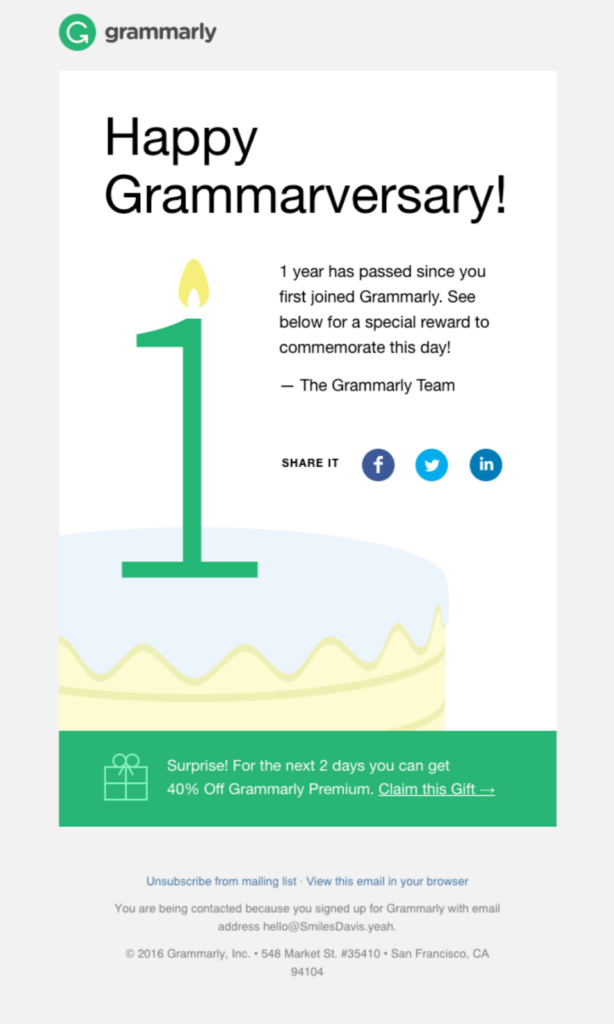
3. Analyze Marketing Performance
Marketing professionals need to evaluate the effectiveness of their strategies. The reason is that it’s essential to look back on your efforts. This approach lets you determine what worked and what didn’t. As a result, you can concentrate on the best techniques and increase return on investment (ROI).
Marketing analytics software provides insights into visitor behavior, website rankings, and competitor activity. Additionally, it can aggregate information from various channels to compare their effectiveness.
What tools can you employ for measuring your marketing performance? For example, Google Analytics. It’s a free and popular solution for accessing the following information:
- your website visitors, their location, age, gender, interests, etc.;
- conversions;
- bounce rates on different pages;
- the popularity of your keywords, and much more.
Or you may get advanced tools like Ahrefs, SEMRush, and Buzzsumo as well-liked solutions. A case in point is SEMRush, which offers numerous tools for comprehensive analysis. The platform allows you to monitor the following:
- search results;
- display ads;
- backlinks;
- keywords;
- how competitors perform on the web;
- your and their position in search engines.
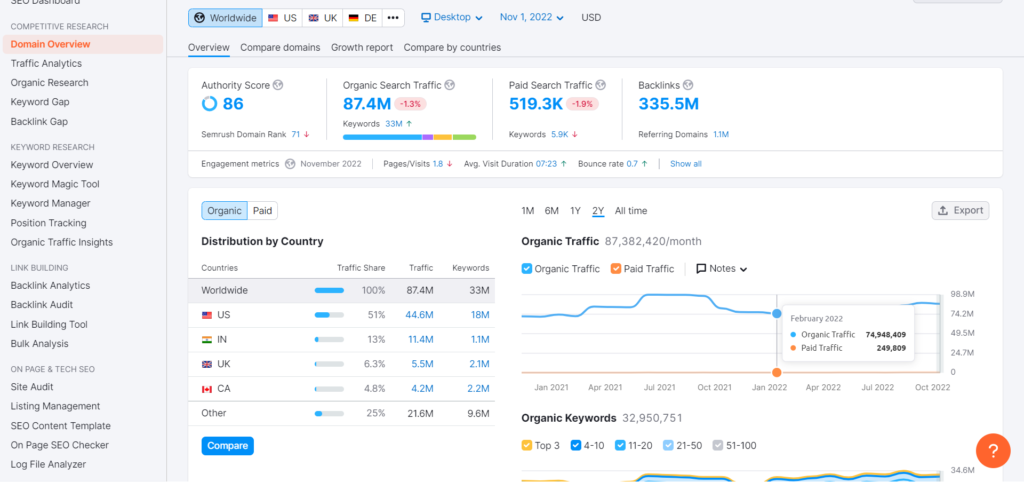
Conclusion
Automation simplifies all business areas. It relieves employees from spending time on specific tasks. So more and more SaaS companies automate every aspect of their business, such as:
- email send-outs;
- lead scoring;
- auto-reminders;
- auto-publishing of social media posts, among other techniques.
This step improves everything from customer acquisition and sales to daily office routines. Automating repetitive work processes lets SaaS business owners save resources. They can spend time and money on more important duties instead, such as implementing UX search best practices or others.
So is automation necessary for SaaS businesses? Our answer is definitely yes! Do you automate processes in your SaaS company? Share your tips, challenges, and achievements after implementing marketing automation.
Tags:
SaaS GrowthNovember 15, 2022



Comments